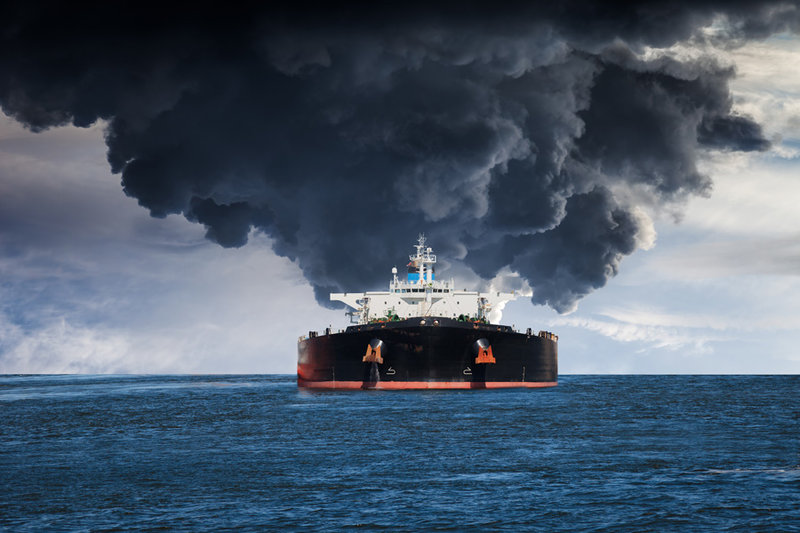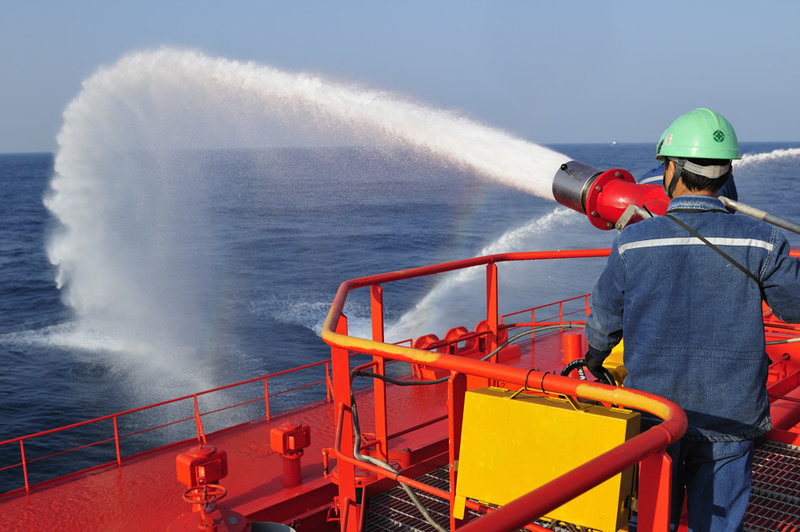Safety
Dousing the flames:
what should be done to prevent fires on container ships?
Traditional precautions against container ship fires are failing to protect crews and cargoes. Joe Baker finds out what is causing fires on-board container vessels and what should be done to prevent this from a regulatory and practical standpoint.
Image: Chris Mirek Freeman/Shutterstock.com
In March,
the Maersk Honam container vessel was sailing hundreds of miles south-east of Salalah, Oman, when it erupted into flames. Nearly two months later, it was dragged into port at Dubai, embers still flickering in the hold. Of the 27 seafarers who had been on-board when the fire struck, 22 were able to abandon ship. The remaining five never returned.
This abject tragedy was only the latest out of a string of many container ship fires that have plagued the maritime industry in recent times. Other shocking incidents in the last five years occurred on-board the MSC Daniela, CMA CGM Rossini and the Hanjin Green Earth.
These disasters have reopened the conversation about the difficulties of preventing and extinguishing fires on the open sea. In an era when ships are larger than they have ever been before, seafarers are often ill-equipped to monitor and contain fires themselves, leaving the task to tugboats that can take days or weeks to arrive. Each failed attempt presents a sizeable environmental, financial and, most importantly, human cost.
A number of marine insurers, including the International Union of Marine Insurers (IUMI), Allianz, the Swedish Club and DNV GL have spoken out about the industry’s failure to address containership fires. However, for a number of reasons, they face an uphill struggle.
Stuart Rivers, CEO of Sailors’ Society.
Image courtesy of Sailors’ Society
Misdeclared cargo
The cause of the Maersk Honam fire is currently the subject of an ongoing investigation. Nevertheless, evidence from previous incidents points to hazardous cargo being misdeclared as a primary factor.
Introduced more than half a century ago, the International Maritime Dangerous Goods (IMDG) Code governs the carriage of materials deemed hazardous on cargo vessels. Based on 2016 figures, the International Cargo Handling Coordination Association estimates that 5.4 million containers are packed with dangerous goods (DG) every year.
The IMDG Code is evolving to impose stricter rules on DG cargo, and affected shippers are beginning to update their stowage procedures. In the wake of the Honam fire, Maersk Line selected the American Bureau of Shipping (ABS) to lead a workshop to evaluate hazards on container ships, many of which ABS said are ‘not fully addressed by the IMDG code’. As a result of the workshop, DG cargo will no longer be stored near crew quarters or engine rooms on Maersk ships, while cargo classified as fire-resistant will always be placed above deck.
“We are encouraged by the outcome of this workshop, which will lead to further safety improvements to be considered for the IMDG Code,” said Ole Graa Jakobsen, Maersk Line’s head of fleet technology. “With ABS and other leading international partners, we will now work to implement the recommendations we have identified.”
Once the cargo is inside containers, it is difficult for seafarers to know whether their contents should be classified as DG or not
Nevertheless, once the cargo is inside containers, it is difficult for seafarers to know whether their contents should be classified as DG or not. This creates an incentive for companies to avoid higher cargo rates by misdeclaring the cargo as non-hazardous, thus allowing it to be stowed in hard-to-access areas on-board ships. This hinders crew members’ ability to deal with fires, as well as posing the added danger that certain chemicals may react with water to form flammable gases.
Even as rules grow stronger, sceptics point out that this still won’t do much to dissuade shippers from misdeclaring cargo. Hapag-Lloyd spokesperson Nils Haupt told JOC that shippers already have to sign DG container packing certificates, and that the company doesn’t believe “stricter rules on shippers would help anything”.
According to Uwe-Peter Schieder, vice-chairman of IUMI’s Loss Prevention Committee, the issue is not with the IMDG code itself, but rather with the level to which countries are willing to put in stricter enforcement systems and checks for misdeclared cargo. While coast guards in the US and certain European countries do open containers and impose penalties for wrongdoing, the same cannot be said globally.
“If we get more and more containers on-board, the chance that we will have a fire on-board [due to] misdeclared cargo is much bigger,” Schieder says. “What we need worldwide is a control system from coastguard to the police in every country to say ‘OK, here’s a container - what is in it?’”

Image courtesy of

Image courtesy of
Ineffective firefighting capabilities on ships
Stronger regulations on cargo are one thing, but ensuring that container ships are able to fend off fires is a whole other issue.
Safety of Life at Sea (SOLAS) regulations have historically included legal requirements that dictate which firefighting systems should be on board. Nevertheless, according to IUMI, these regulations were originally designed for smaller general cargo ships of a bygone era, and aren’t suitable for today’s megaships.
For example, CO2 deployment systems installed on container ships are now ineffective. Often the gas is unable to penetrate the walls of containers and if they contain a lot of oxygen, the fire will continue to burn regardless. When fire moves to the deck of a container ship, the absence of natural fire compartments makes it difficult to contain it and cooling the decks with water is also impossible due to a lack of suitable equipment.
Ships are also not required to deploy fire detectors on deck. Schieder says that on vast ships with a relatively low number of seafarers on board - most of whom won’t be checking the temperature of containers regularly - the chances of recognising incipient fires before they spread are very slim.
SOLAS regulations were amended in 2016 with a number of changes designed to bring fire protection up to speed. For example, ships designed to carry containers above deck should be fitted with at least one water mist lance. However, IUMI claims that the new measures don’t go far enough, and that sending seafarers in to douse fires using hoses still presents immediate dangers.
In 2016, statistics obtained by local media from SLPA showed that the port was almost operating at a loss

Image courtesy of
New fire safety solutions
Last year, the German Insurance Association (GDV) proposed a number of technical improvements that could be added to ships. It claimed that individual compartments should be added below deck to prevent fires from spreading, while a water-based firefighting system should be deployed to cool the vessel’s structure and cargo.
Water curtains - which Schieder says were being used on smaller cargo ships 40 years ago - could be used to separate sections and cool infrastructure above deck. GDV also proposed that infrared cameras and thermal systems should be mounted on-board ships to help detect when containers breach a certain temperature.
There is a number of practical challenges involved with installing these systems; the placement of monitors and sensors should not get in the way during loading, for example. Nevertheless, a primary concern will be cost. Schieder says that retrofitting older vessels will be too expensive for many shippers, but there is hope that new-builds could adopt stronger fire protection measures as part of their design.
Retrofitting older vessels will be too expensive for many shippers, but there is hope that new-builds could adopt stronger fire protection measures
“The costs will definitely be three, four or five times higher than if you plan a cooling system directly for a new-build ship,” he says. “Sometimes it is impossible, but if you build ships new the costs will be 1 or 2% lower.”
IUMI’s Marine Loss Prevention Committee will continue to push the International Maritime Organization (IMO) to put container ship safety on its agenda, and raise awareness of better fire protection measures to shipping companies and member states. This will likely require a costly formal safety assessment of container ships, but with the damaging effects of recent fires, a wake-up call is well overdue.
“Our children will be the seafarers of tomorrow and so we should give them a chance to produce a better product, and that product is the safe carriage of goods from all around the world,” Schieder says. “We need ten to 15 years to change it, but today is the day we start to change.”
